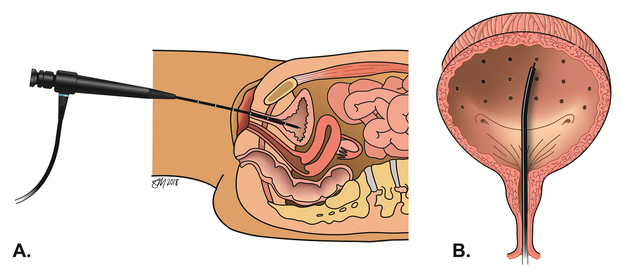BOTOX (Onabotulinum toxin Type A)
|
Botox®, or onabotulinum toxin Type A, is an effective treatment option for urgency urinary incontinence or overactive bladder symptoms in women with and without underlying neurologic disorders.
In both of these conditions, the muscle in the wall of the bladder, called the detrusor muscle, may contract too often or at inappropriate times. This can cause sudden urgency to urinate, sometimes with urinary leakage. Many people may recognize the name Botox®. This is a brand name for onabotulinum toxin Type A, a protein obtained from bacteria in a controlled laboratory setting. When injected into the bladder wall, onabotulinum toxin Type A works by relaxing the bladder muscle, preventing the excessive contractions that cause symptoms. How Are Onabotulinum Toxin Type A Injections Performed? At Northwestern Medicine, your urogynecologist will determine if you are a good candidate for onabotulinum toxin Type A injection into your bladder. Women with urgency incontinence are good candidates for onabotulinum toxin A if they have tried behavioral changes or physical therapy and do not want to take, did not get benefit from, or could not tolerate the side effects of daily medications. The procedure is done by your urogynecologist in the office. A numbing gel will be placed in your urethra, and a cystoscope will be placed into your bladder. A cystoscope (image A) is a thin camera with a light inside that allows your urogynecologist to look inside your bladder. The onabotulinum toxin Type A is then injected into the bladder muscle through the cystoscope (image B). The entire procedure takes 5 minutes and causes minimal discomfort. You will be able to go home by yourself right after the procedure. How Successful Is Onabotulinum Toxin Type A?
Onabotulinum toxin Type A is a very effective treatment for urgency incontinence or overactive bladder symptoms. Clinical trials demonstrated the effectiveness of onabotulinum toxin Type A in the treatment of urgency incontinence and refractory urgency incontinence in healthy women and those with neurologic disorders, such as multiple sclerosis and Parkinson’s disease. The effects of onabotulinum toxin Type A are not permanent, typically lasting for six to nine months, and the procedure can be repeated after it wears off. Are There Risks or Side Effects? There are two temporary risks associated with onabotulinum toxin Type A:
Depending on the dosage of onabotulinum toxin Type A injected into your bladder, you have a 5 to 10 percent chance of temporarily needing to empty your bladder with a catheter. Therefore, we recommend that you learn to perform self-catheterization prior to the procedure—our nurses will teach you how to do this quite easily. What Is the Recovery? Onabotulinum toxin Type A does not work instantly; it takes up to two weeks to reach its full effect. It is not uncommon to have some burning or even a small amount of bleeding with urination immediately after your procedure, but this resolves quickly. It is also normal to feel a sense of urgency to urinate immediately after the procedure, but this will subside over the course of the day. |
To Request an Appointment
If you're suffering from a pelvic floor disorder, you don't have to live with the symptoms. To learn about treatment options, call 312.694.7337 to schedule an appointment with one of our urogynecologists. MEET OUR TEAM
Our transdisciplinary team works together to ensure that each patient receives a tailored and highly individualized plan of care. |




